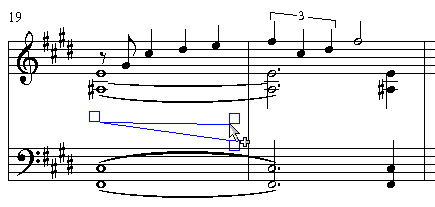
lush harmonies (notes are close together in pitch and are consonant - pleasing to the ear. Due to Adagio falling between the terms Lento and Andante, the latter would be acceptable.) Adagio tempo (based on dotted crotchet beat. calm, gentle, lilting 6/8 time signature. Responses may include (but are not restricted to). write brief notes on how the concepts of music are used to reflect the scene in the painting. tremolo –rapid repetition of one note (unmeasured). trills –rapid alternation of two pitches next to each other. sul tasto – bowing over the end of the fingerboard. sul ponticello – playing very close to the bridge. discuss expressive techniques and tone colours by following along with the break down on the Winter handout. listen to Vivaldi's musical interpretation of his text (09:29). Were dynamics used? How? Were they effective and well-considered?. Were unusual expressive techniques used in performance? How did these reflect the text?. How did the group decide on their performing media? (Did students only play the instruments they know or did they experiment with other instruments to achieve the tone colour they were seeking?). perform it for the class for peer discussion and feedback. Please note - the composition does not need to be notated, rather, students can keep brief annotations of their ideas and structure. compose and practise their piece (no longer than one minute in length). discuss and write down ideas about the type of performing media, tone colour, dynamics and expressive techniques that could be used to aurally communicate the text - without lyrics. form groups of 3-4 and select one paragraph to use for the next few steps. read the text from Vivaldi's Winter concerto on the Winter handout (PDF 4.27 MB) and complete the exercises below:. watch the Line Rider - Mountain King (02:46) video and write a paragraph discussing the use and effectiveness of the animation. compare and discuss the teacher's music map in the hall of the mountain king teacher (PDF 4.35MB). the changes in dynamic levels and tempo. complete a music map of the piece that identifies the sections present.  What instruments are added toward the end of the piece?. What does accelerando mean and when does it begin to happen in the music?.
What instruments are added toward the end of the piece?. What does accelerando mean and when does it begin to happen in the music?. 
What is a crescendo and how it is achieved in this piece?.What happens the second time the theme is played?.When the opening theme is played, what instrument begins the ostinato in the accompanying part?.Which instruments play the theme first? How are they played (what expressive technique do they use)?.What is the story behind this particular movement?.research and respond to the following questions:.listen (no visuals) to the piece In the hall of the mountain king by Edvard Grieg (02:33) and discuss what 'story' they think the music is telling.






 0 kommentar(er)
0 kommentar(er)
